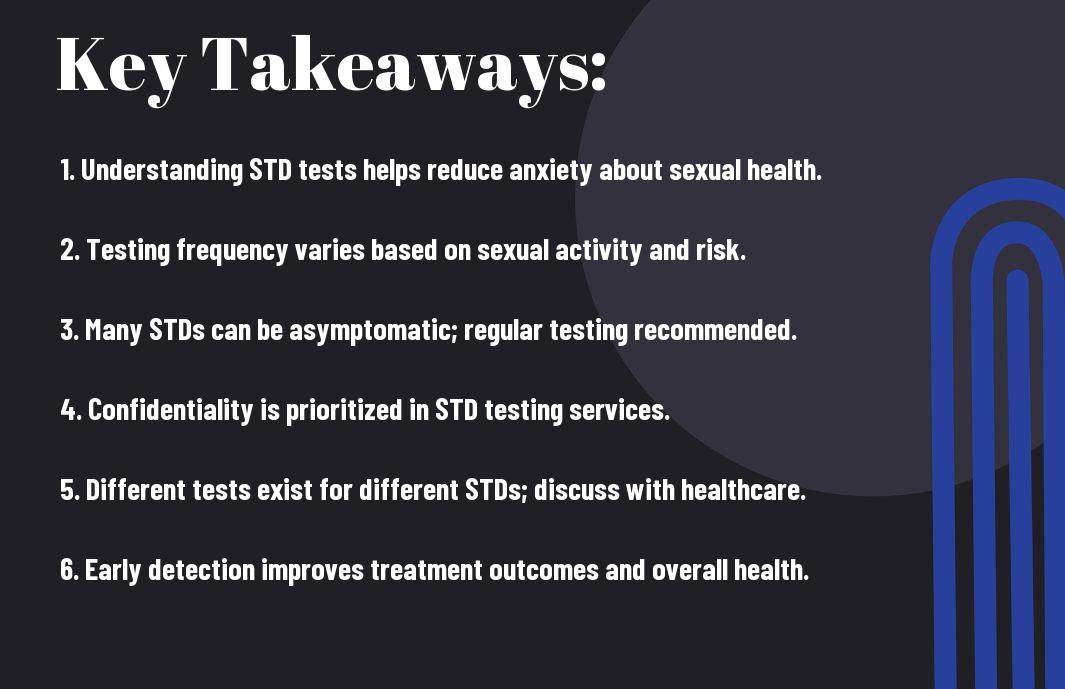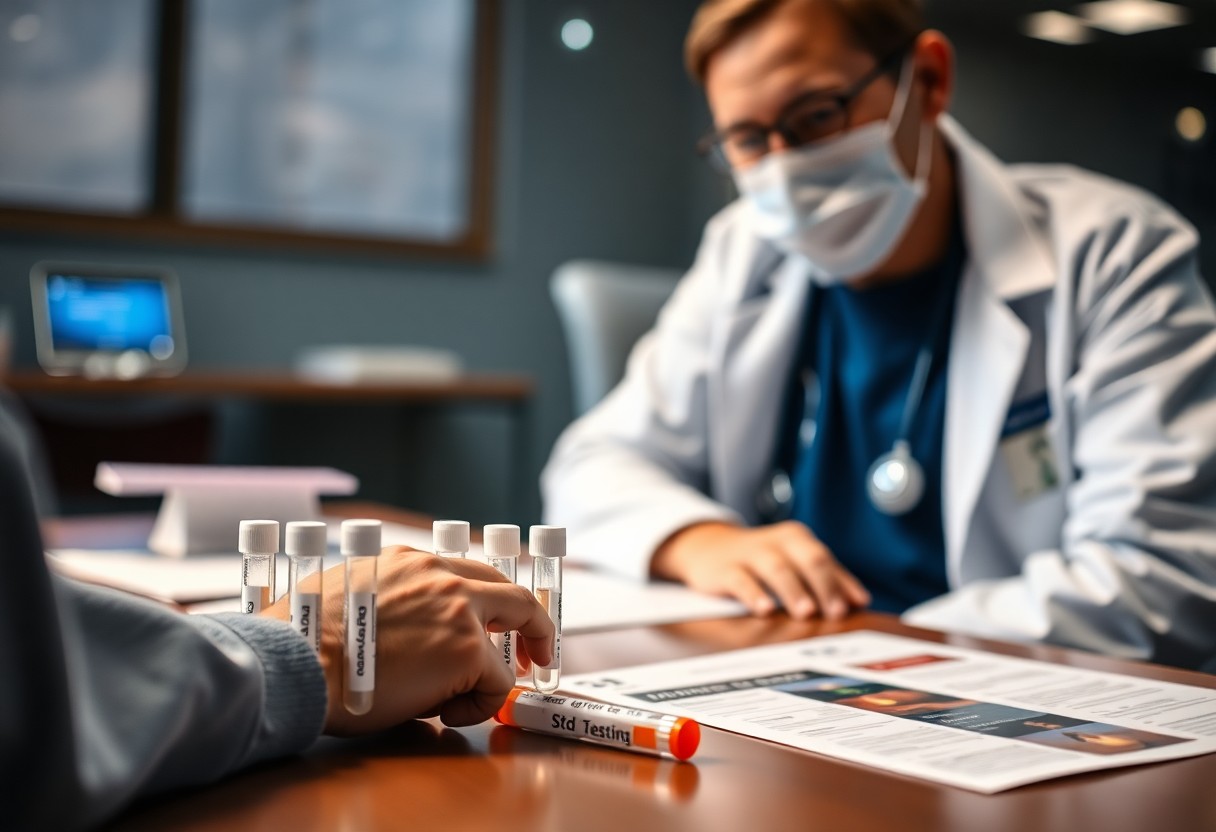Over time, many individuals have questions about STD tests and their importance for your sexual health. This blog post will address some of the most common concerns you may have regarding testing, including the types of tests available, what to expect during the process, and how to interpret your results. Understanding these aspects can empower you to make informed decisions about your health and provide you with the peace of mind you deserve.
Key Takeaways:
- Types of Tests: There are various STD tests available, such as blood tests, urine tests, and swabs, each designed for specific infections.
- Testing Frequency: It’s recommended to get tested regularly, especially if you have multiple partners or engage in unprotected sex.
- Symptoms vs. Asymptomatic: Many STDs can be asymptomatic, meaning individuals may not show symptoms but can still transmit infections.
- Confidentiality: STD testing is often confidential, allowing individuals to seek care without fearing stigma or breach of privacy.
- Treatment Availability: Many STDs are treatable, and early detection can lead to better health outcomes and reduced transmission risks.

What Are STD Tests?
Your sexual health is imperative, and STD tests are a critical step in ensuring it. These tests are medical procedures used to detect sexually transmitted diseases or infections in your body. Regular testing plays a significant role in early detection and treatment, enabling you to maintain a healthy lifestyle and protect your partners. By understanding what these tests entail, you can take proactive steps for your wellbeing.
Types of STD Tests
Your options for STD testing vary, and knowing the types can guide your choice:
- Blood tests – Used for HIV and syphilis.
- Urine tests – Common for chlamydia and gonorrhea.
- Swab tests – Effective for herpes and HPV.
- Physical exams – Assess physical symptoms.
- Home testing kits – Convenient for private testing.
Recognizing the different test types empowers you to make informed decisions about your sexual health.
| Test Type | Sample Type |
| Blood Test | Blood Sample |
| Urine Test | Urine Sample |
| Swab Test | Swab from Genitals |
| Physical Exam | Clinical Examination |
How STD Tests Work
After you decide to get tested, you’ll go through a straightforward process that ensures your comfort. You may visit a healthcare provider or opt for home testing kits. During an appointment, a health professional will collect samples from your blood, urine, or swab your genitals. The samples are then sent to a laboratory for analysis, and results typically take a few days. If you test positive, your healthcare provider will discuss treatment options, which could include medication and lifestyle adjustments.
The accuracy of STD tests largely depends on the type of test used and when you are tested after potential exposure. Various STDs present different *window periods*, meaning that testing too early might not provide reliable results. The tests are designed to reveal infections that may exist without noticeable symptoms, particularly for diseases like chlamydia and gonorrhea, which are often asymptomatic. Being proactive about your sexual health through these tests is imperative in safeguarding yourself and your partners from potentially severe health complications and spreading infections.
Who Should Get Tested?
One of the most important steps in maintaining your sexual health is understanding who should get tested for STDs. If you are sexually active, particularly with multiple partners or without protection, it is advisable to get tested. This also applies if you have a new partner or if you experience any symptoms associated with STDs. Regular testing can help ensure your peace of mind and protect your partners.
Recommended Testing Frequency
Below are some guidelines on how often you should get tested for STDs. If you are sexually active, especially with new or multiple partners, aim for testing every six months. If you are in a monogamous relationship, annual testing is advisable. Tailor your frequency based on your personal situation and lifestyle, and always consult with a healthcare provider for personalized recommendations.
High-Risk Populations
Across various demographics, certain groups are identified as high-risk for STDs. This includes individuals with multiple sexual partners, men who have sex with men, and those engaged in unprotected sex. You should consider testing if you fall into these categories or if you’re a healthcare worker potentially exposed to infectious body fluids.
Plus, if you are part of a high-risk population, regular testing becomes even more necessary. Engaging in unprotected sex, having multiple partners, or being in a relationship where your partner has an STD increases your risk of exposure. It’s vital to prioritize your sexual health and seek testing not only for your benefits but also to protect your partners. Maintaining open communication and getting tested regularly can significantly mitigate the risks associated with STDs.
Understanding the Testing Process
Despite the anxiety that often accompanies the thought of getting tested for STDs, understanding the testing process can alleviate some concerns. Testing usually involves a simple procedure, which may include a physical examination, urine samples, or blood tests. Knowing what to expect helps you prepare mentally and physically, and it ensures a smoother experience overall.
What to Expect During a Test
Above all, you can expect the testing environment to be professional and supportive. The process typically involves answering some questions about your sexual history, followed by the sample collection, which can be quick and straightforward. Your healthcare provider will guide you through each step, so don’t hesitate to ask questions as needed.
Confidentiality and Privacy Concerns
With an increasing emphasis on patient confidentiality, you can feel assured that your personal information will remain private throughout the testing process. Most clinics and healthcare providers take significant measures to maintain your data securely, so you can focus on getting the care you need.
Understanding the protocols surrounding confidentiality can greatly increase your comfort level. Health care providers are bound by strict regulations to protect your personal health information. This means your results will only be shared with you and authorized personnel. Additionally, most clinics offer anonymity during the testing process, allowing you to access services without fear of judgment. It’s important to choose reputable organizations that prioritize privacy, ensuring you can seek the care you need without worry.

Interpreting Your Results
Now that you’ve received your STD test results, it’s important to understand what they mean for your health. Each result can tell you something different, and interpretations may vary based on your personal health history and specific circumstances. Whether your results are positive or negative, you should consult with a healthcare professional to receive a comprehensive understanding and personalized advice tailored to your needs.
Understanding Test Outcomes
Above all, it’s crucial to recognize that a positive test result indicates an active infection that requires attention and treatment, while a negative result often suggests you are currently free of the infection. However, some tests may not detect infections that are newly acquired, so follow-up testing may be recommended in certain situations.
Next Steps After Receiving Results
Around the time you get your results, consider what actions to take next, especially if your results are positive. It’s vital to reach out to your healthcare provider to discuss treatment options and any necessary follow-up care. Ensure that you also inform any recent sexual partners, as they may need testing or treatment as well.
But if your results show a positive outcome, you must act promptly to address the situation. Contact your healthcare provider to explore effective treatment options tailored specifically for your infection. Not only will this help protect your health, but it will also ensure you’re taking steps to prevent transmission to others. If your results are negative, consider adopting preventive measures, such as regular testing and practicing safe sex, to maintain your sexual health moving forward.
Common Myths About STD Testing
Many people assume that STD testing is only necessary if they exhibit symptoms or if they believe they have been exposed. However, this is a misconception. Routine testing is vital for maintaining your overall health, as many STDs can be asymptomatic. For more information, check out this article on Should I Get Tested for a Sexually Transmitted Infection?. Taking proactive steps to prioritize your sexual health can prevent the spread of infections and protect you and your partners.
Debunking Misconceptions
After dispelling myths surrounding STD testing, it’s vital to understand that testing is a normal part of sexual health. Many believe that only individuals with multiple partners need testing, but everyone, regardless of their sexual history, should be informed about their health status. This knowledge empowers you to make safer choices and reduces the stigma often surrounding these discussions.
The Importance of Regular Testing
Between sexual partners, it’s important to consider the significance of regular STD testing. Each time you have new sexual encounters, you expose yourself to potential infections. Regular testing helps you stay informed and take necessary protective measures to safeguard your health.
This proactive approach to health ensures that you can identify and address any issues early on. By getting tested regularly, you not only protect yourself but also contribute to the well-being of your partners. Detecting STIs early leads to better health outcomes and reduces the likelihood of transmission. Prioritizing your sexual health through consistent testing reflects an informed and responsible attitude towards intimacy.
Resources for Further Information
Unlike the common myths surrounding STD testing, a wealth of resources exists to help you make informed decisions. From health organizations to online platforms, you can find information that addresses your questions and concerns about sexually transmitted diseases and testing options. Utilizing these resources can enhance your understanding of your sexual health, empowering you to take proactive steps.
Where to Get Tested
With various options available, you can choose from local health clinics, hospitals, or dedicated sexual health centers for STD testing. Many of these facilities offer confidential services and knowledgeable staff who can guide you through the process. Additionally, at-home testing kits are also popular, providing a convenient way to check your status comfortably.
Educational Resources
Educational resources are crucial for understanding STDs and their implications. Numerous reputable organizations, including the Centers for Disease Control and Prevention (CDC) and the World Health Organization (WHO), provide comprehensive educational materials. These resources can help you grasp the risks, transmission methods, and symptoms of various STDs, ultimately aiding in prevention and treatment strategies.
Understanding the range of educational resources available to you can enhance your knowledge about sexual health. Websites, brochures, and videos from organizations such as the American Sexual Health Association (ASHA) can clarify misinformation and help you make informed choices. Utilizing these resources empowers you to engage in safer sexual practices, seek appropriate testing, and remain informed about latest treatment options.
FAQs About STD Tests – Common Questions Answered For Your Peace Of Mind
Q: What types of STD tests are available?
A: There are several different types of STD tests available, including blood tests, urine tests, and swabs. Blood tests can detect infections such as HIV, syphilis, and hepatitis, while urine tests are commonly used for chlamydia and gonorrhea. Swabs may be taken from genitals, throat, or rectum to test for infections like herpes or HPV. It’s crucial to consult with a healthcare provider to determine the appropriate tests based on your risk factors and symptoms.
Q: How often should I get tested for STDs?
A: The frequency of STD testing depends on individual risk factors. If you are sexually active with multiple partners, have a new partner, or engage in unprotected sex, it’s a good idea to get tested at least once a year. Those at higher risk may need more frequent testing. For individuals diagnosed with an STD, follow-up testing may be required to confirm the infection has cleared after treatment.
Q: Is STD testing confidential?
A: Yes, STD testing is confidential. Most healthcare providers and clinics prioritize patient privacy and will keep your results and medical history secure. You can choose to have your tests done at a local health department or a specialized clinic if you prefer additional anonymity. Always inquire about privacy policies when seeking testing services.
Q: What should I do if I test positive for an STD?
A: If you test positive for an STD, it’s important to follow up with your healthcare provider for guidance on treatment options. Many STDs can be effectively treated or managed, but prompt action is crucial. Additionally, inform any sexual partners so they can get tested and treated as necessary. Practicing safe sex in the future can help prevent the spread of STDs.
Q: Can I get tested for STDs at home?
A: Yes, there are home testing kits available for certain STDs. These kits allow you to collect samples in the privacy of your home and send them to a laboratory for analysis. While this is a convenient option, it is critical to choose a reputable company and ensure the tests are FDA-approved for accuracy. Be sure to discuss the results and next steps with a healthcare professional.



